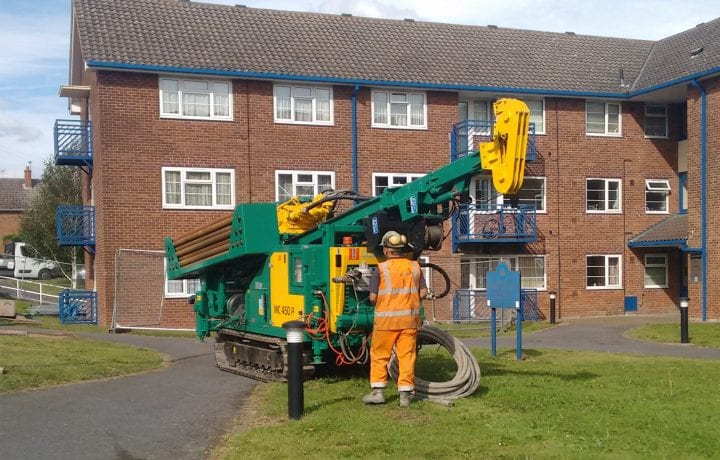Follow a real-life ground source heat pump retrofit project as Kensa Heat Pumps and Trent & Dove Housing share regular live blog feeds documenting their latest heating upgrades project.
From the 4th August to the 25th October 2015, Kensa will be sharing regular live project updates via its blog page to provide an honest perspective on key project milestones during their latest ground source heat pump retrofit scheme with Trent & Dove Housing in Burton on Trent.
Featuring the replacement of night storage heaters with ground source heat pumps in 60 flats in Burton on Trent, this will be the first live project blog of its kind, featuring Kensa’s innovative micro ground source heat network.
Following their recent landmark retrofit scheme featuring the installation of Kensa ground source heat pumps in 133 bungalows, Trent & Dove knew the ground source solution could address common night storage heating complaints in their multi-occupancy dwellings at Chestnut Mews and Aspen Mews in Burton on Trent.
With tenants reporting savings of between £350 – £750 following the installation of a Kensa ground source heat pump at previous Trent & Dove project sites, Trent & Dove Housing are keen to ensure many more of their tenants also benefit from this reliable renewable technology.
The issue with storage heaters is well documented, with the most popular complaints amongst users being high running costs and poor controls. Worse still, storage heaters consistently run out of energy before the end of the day, meaning tenants have to top up heating with portable direct electric heaters to stay warm at night when they need the heat the most, causing even higher heating bills as the top-up heaters run on the peak rate side of the E7 meter. Other than burning five pound notes this is one of the most expensive ways to heat a property!
Many tenants will also be on key meters meaning they are paying a further premium on the cost of the electricity, forcing many to be able to afford to heat only a single room. The implications of this on tenants’ health is a grave concern to many, which is why Trent & Dove Housing are now embarking on a second phase of heating system upgrades in their rural off gas housing stock with Kensa ground source heat pumps.
Trent & Dove’s latest ground source project sites at Chestnut Mews and Aspen Mews are made up of two blocks of three story flats, totalling 60 units. Using Kensa’s innovative micro-district ground source heat pump solution, linking multiple heat pumps to a common ground array, Trent & Dove are able to offer their tenants controllable, affordable warmth in their homes, whilst at the same time accessing significant grant funding via the ECO and Non-domestic Renewable Heat Incentive (RHI – this scheme has closed).
At Chestnut and Aspen Mews each vertical column of three flats will be connected to a pair of boreholes via an external riser. With each flat receiving its own Kensa 6kW Shoebox heat pump fitted inside the home, tenants retain individual control, and importantly, individual billing. And as the circulating pumps to the boreholes are individual to each unit, there are no centralised running costs to manage and bill.
The layout of the two blocks is ideal for the ground source heat pump solution as there is plenty of flat, open land around all sides of the apartments. This allows the boreholes to be located near to the buildings they are serving, minimising trenching and disruption, but also allowing the boreholes to be spread out across the site, spreading the areas from which the energy is drawn from the ground.
Now that Trent & Dove have committed to the scheme the first phase of work is under way, which comprises survey and design to confirm heat losses and building loads, as well as the desktop ground array design.
Kensa has also started the tenant liaison process, educating the tenants on the upcoming scheme, the benefits to them and any potential disruption during the process. Kensa representatives, along with Trent & Dove’s tenant liaison team have met each of the tenants individually to explain the process and answer any concerns the tenants may have about the installation. Generally the feedback has been very positive, and as you would expect, most are very keen to see an alternative solution to their existing inadequate heating system, and are looking forward to a warm affordable winter.


